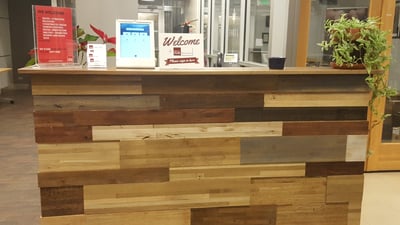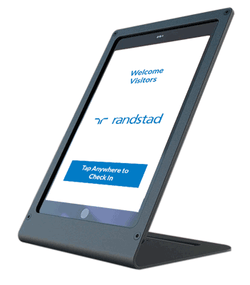Advantages of Digital Visitor Sign in App | Visitor Registration
A digital visitor sign in app helps small offices save money and increase productivity. See the advantages of this easy-to-use automation software.
A deep dive into why workplaces are adopting front desk sign-in apps and how to choose the right visitor registration app for your organization.
Self-service visitor check-in kiosks are a part of everyday life. You may not have thought too much about them, but it is likely you’ve used one at the airport, at a large office building, maybe even at a hotel, museum, or car rental location. Fewer businesses are staffing their front desks with traditional, dedicated receptionists. Instead, they are replacing or reinforcing their existing personnel with automated touch screens containing visitor management systems.
These user-friendly systems, also known as visitor registration systems or sign-in apps, are incredibly useful for businesses and visitors alike.

Front desk sign-in apps are electronic alternatives to traditional sign-in sheets, paper visitor logbooks, or traditional receptionists who request and record visitor information. When using a sign-in app, visitors simply check-in using an iPad receptionist, tablet, or laptop located in the lobby area.
These visitor registration apps gather and record information every time a visitor enters the building. If necessary, visitor photos can be taken, badges can be printed and eSignatures can be obtained, all right within the app itself.
 There are multiple reasons why a business might choose to use a sign-in application.
There are multiple reasons why a business might choose to use a sign-in application.
Front desk sign-in apps offer these advantages to organizations of any size at a fraction of the cost of hiring more staff. This frees your existing staff – and existing funds – to be utilized in the best way possible to increase business productivity.
Once you’ve decided to a visitor sign-in application is the right way to greet guests to your workplace, there is no reason to be daunted in determining which option is best for your organization. A few key features can help you choose and should be carefully considered during your selection process.
 Ease of Use
Ease of UseThe goal of a sign-in app is to make your business more efficient. The last thing you want is something cumbersome to set up or to use on a daily basis. A great sign-in app will:
Great sign-in apps will go beyond being user-friendly; they will be workplace and brand-friendly, meaning that you can easily customize the app to make sure it accomplishes exactly what your business wants and needs it to. Your business is unique, and your sign-in app should be able to reflect that. Really great registration apps allow you to customize their appearance with your logo and branding to set the tone for your guests, leaving a memorable professional impact on your visitors.
Customization can take a few different forms, but here are some features to look for.
Your organization undoubtedly hosts more than one type of visitor, and each of those visitor types has different needs. The app should support a variety of check-in scenarios such as visitors for special events like job fairs or social events, meeting participants, vendors, interview candidates, and delivery personnel for packages and food deliveries.
Imagine if the first screen had selections like this which would allow guests to route themselves more easily:
Based on what the guest selects, the person would be routed via the app to screens that requested different information.
In addition to accommodating different check-in scenarios, great apps can do customized processes as necessary for each scenario. Guests attending a special event may be automatically added to your organization’s CRM. The system might require vendors or prospective employees to electronically sign a non-disclosure agreement or other official documents.
A little programming and advance planning can go a long way to making the check-in process easy for guests and incredibly useful and robust for organizations.
Reception notifications must be fast to be effective, and if there is one thing that has changed in the workplace in the last 10-15 years, it is how we communicate. Where the desk phone used to be the primary mode of contacting an employee to tell them a visitor had arrived, this is absolutely no longer the case. With employees in meetings, or working from laptops in the courtyard, making a phone call or escorting a guest is often a slow process.
When considering visitor registration apps, you will want to choose one that can notify your employees via multiple channels, such as:
In addition, such an application should give individual employees the ability to customize their notification preferences. If an employee knows they see texts the fastest, but never check email, they can adjust their profile preferences accordingly.
The very best applications will integrate with your company’s LDAP/directory services, totally automating the admin process. The app can access your directory of employees with your existing LDAP like Active Directory and Azure AD to retrieve their information and contact them as quickly as possible.
Inadequate security can leave your business vulnerable to violence, terrorism, and industrial espionage. Additionally, as many businesses undergo digital transformations, they become vulnerable to security issues such as data breaches. Small businesses account for 71% of data breaches.
Purchasing an app with the following features can enhance your office's security and protect your employees, inventory, and intellectual property.
 Cost-Effective
Cost-Effective(Not to brag but G2 recently named Greetly "Best ROI" in the visitor management category.)
There are a lot of sign-in apps to choose from on the market today, and choosing one with a fair price tag can be a challenge. Pricing can vary widely depending on the type of equipment required, plan capacities, app capabilities, and more. The best apps will be efficient and cost-effective. Some things to look for when pricing applications:
Smart organizations understand the value of using technology to supplement and support their personnel. Technology can do the drudge work of collecting information and contacting hosts while employees can focus on other important work. At the same time, this software can add extra layers of security to your check-in process by requiring important information, taking photos, keeping searchable records, and flagging problematic guests.
Visitor check-in software automates visitor registration and is very affordable in comparison to the traditional dedicated receptionist. Your visitor sign-in software should cost just a few dollars a day with no surprises or hidden costs. Whatever money you spend can be a worthy investment to streamline your check-in process, free up your employees and make your guests feel welcome.
A digital visitor sign in app helps small offices save money and increase productivity. See the advantages of this easy-to-use automation software.
Using a virtual receptionist service with a digital reception app automates your reception function and frees up your most valuable resource: your...
Selecting the right check-in app is important as is the visitor kiosk and other hardware. This article helps you choose the right hardware for your...